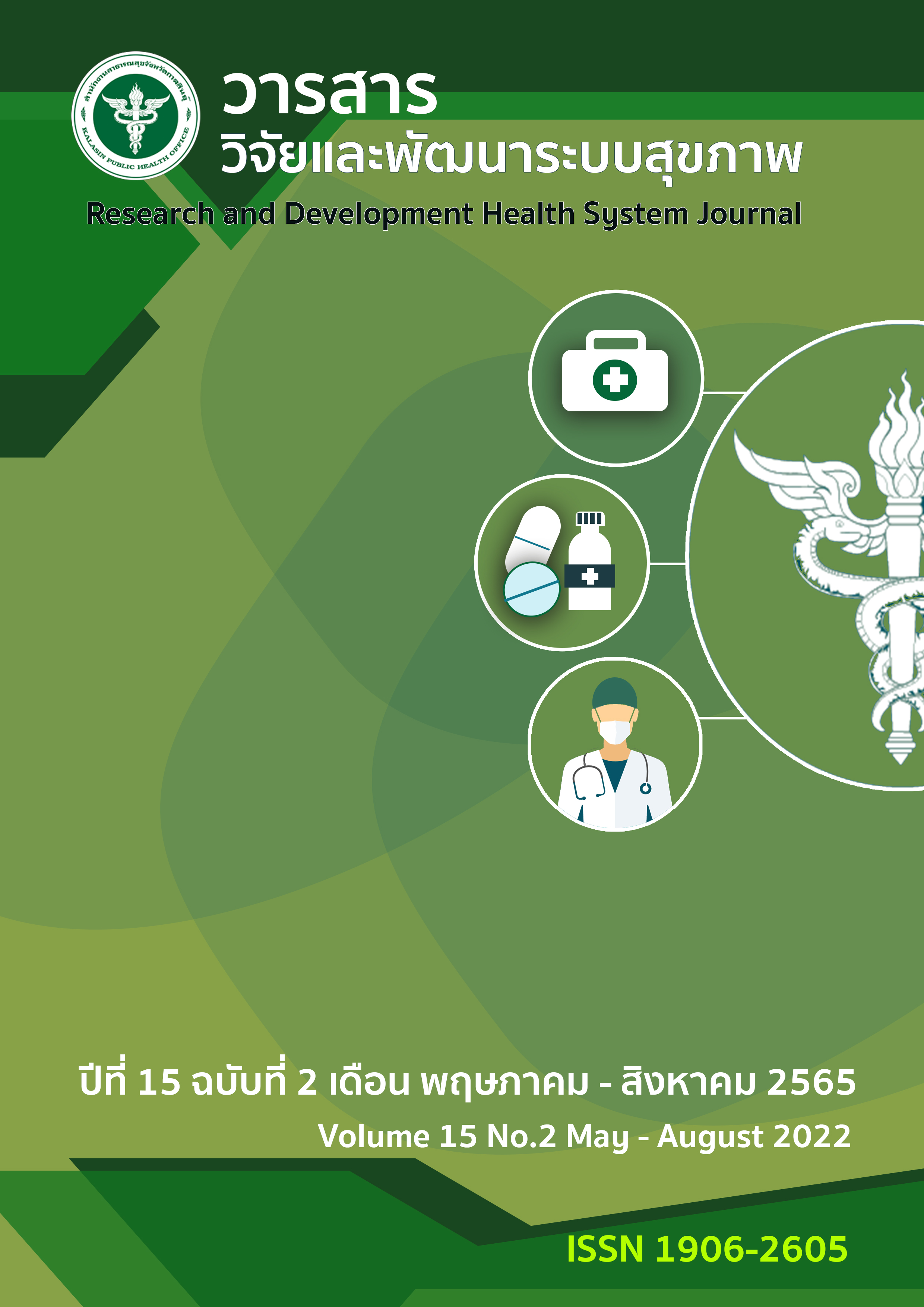สาเหตุของการเข้ารับการรักษาแบบผู้ป่วยใน และปัจจัยที่เกี่ยวข้องกับการกลับเข้ารับการรักษา ภายใน 30 วัน ของผู้ป่วยไตเรื้อรังระยะสุดท้ายที่ล้างไตทางช่องท้อง ณ โรงพยาบาลมหาสารคาม
คำสำคัญ:
การเข้ารับการรักษาแบบผู้ป่วยใน, ผู้ป่วยโรคไตวายเรื้อรัง, การล้างไตทางช่องท้องบทคัดย่อ
การวิจัยนี้มีวัตถุประสงค์เพื่อศึกษาสาเหตุการเข้ารับการรักษาแบบผู้ป่วยในและปัจจัยที่เกี่ยวข้องกับการกลับเข้ารับการรักษาภายใน 30 วัน ในผู้ป่วยไตเรื้อรังที่ล้างไตทางช่องท้อง ศึกษาแบบ Retrospective cohort study โรงพยาบาลมหาสารคาม ช่วง 1 มกราคม 2560-31 ธันวาคม 2564 วิเคราะห์ข้อมูลจากเวชระเบียนและฐานข้อมูลอิเล็กทรอนิกส์ ใช้สถิติเชิงพรรณนา และ multiple logistic regression โดย SPSS version 25
กลุ่มตัวอย่าง 164 ราย ระยะเวลาติดตาม (person time) 204,563 คน จำนวนวันเฉลี่ย 3.42 ปีต่อคน พบว่า อายุเฉลี่ย 55.50 ปี โรคประจำตัวที่พบบ่อย คือ ความดันโลหิตสูง เบาหวาน โลหิตจาง และไขมันในเลือดสูง (ร้อยละ 92.70, 53.70, 53.70, 30.70 ตามลำดับ) มีผู้ป่วยเข้ารับการรักษา ≥1 ครั้ง 114 ราย (ร้อยละ 69.5) รวม 644 ครั้ง เฉลี่ย 1.15 ครั้งต่อคนต่อปี สาเหตุที่พบบ่อย คือ ไตเรื้อรังระยะที่ 5 (ร้อยละ 50.2) ติดเชื้อในเยื่อบุช่องท้อง (ร้อยละ 9.50) โลหิตจาง (ร้อยละ 5.10) ความดันโลหิตสูง (ร้อยละ 3.60) และอุจจาระร่วง (ร้อยละ 1.90) มีผู้ป่วยกลับเข้ารับการรักษา ≥1 ครั้งใน 30 วัน 24 ราย รวม 277 ครั้งจำนวนวันนอนที่เพิ่มขึ้น 1 วัน ลดการเข้ารับการรักษาซ้ำใน 30 วัน ร้อยละ 34 (OR 0.66, 95% CI 0.47-0.93)
ข้อเสนอแนะ คือทีมรักษาควรเน้นดูแลโรคที่พบบ่อยและวันนอนให้เหมาะสมเพื่อลดการกลับเข้ารับการรักษา
Downloads
เอกสารอ้างอิง
สำนักงานหลักประกันสุขภาพแห่งชาติ คู่มือบริหารกองทุนหลักประกันสุขภาพแห่งชาติ ปีงบประมาณ 2553 กรุงเทพมหานคร: สำนักงานหลักประกันสุขภาพแห่งชาติ; 2552.
Thai Renal Replacement Therapy (TRT) Committee. Provision of RRT in Thailand in year 2015. In: Praditpornsilp K, ed. Thailand renal replacement therapy: year 2015. Nephrology Society of Thailand, 2015.
CKD in the United States: An overview of the USRDS annual data report, Volume 1. American Journal of Kidney Diseases. 2015; 66(1):S1–10.
Chan L, Poojary P, Saha A, Chauhan K, Ferrandino R, Ferket B, et al. Reasons for admission and predictors of national 30-day readmission rates in patients with end-stage renal disease on peritoneal dialysis. Clin Kidney J. 2017; 10(4):552-559.
Fried L, Abidi S, Bernardini J, Johnston JR, Piraino B. Hospitalization in peritoneal dialysis patients. Am J Kidney Dis. 1999; 33(5):927-933.
Lovasik BP, Zhang R, Hockenberry JM, Schrager JD, Pastan SO, Mohan S, et al. Emergency department use and hospital admissions among patients with end-stage renal disease in the United States. JAMA Intern Med. 2016; 176: 1563.
Xu Y, Li L, Evans M, Xu H, Lindholm B, Carrero JJ. Burden and causes of hospital admissions and readmissions in patients undergoing hemodialysis and peritoneal dialysis: a nationwide study. J Nephrol. 2021; 34(6):1949-1959.
Perl J, McArthur E, Bell C, Garg AX, Bargman JM, Chan CT, et al. Dialysis modality and readmission following hospital discharge: A Population-Based Cohort Study. Am J Kidney Dis. 2017; 70(1):11-20.
Saran R, Li Y, Robinson B, Ayanian J, Balkrishnan R, Bragg-Gresham J, et al. US renal data system 2014 annual data report: epidemiology of kidney disease in the United States. Am J Kidney Dis. 2015 Jul;66(1 Suppl 1): Svii, S1-305.
Szeto CC, Li PK. Peritoneal dialysis-associated peritonitis. Clin J Am Soc Nephrol. 2019; 14(7):1100-1105.
Boudville N, Kemp A, Clayton P, Lim W, Badve SV, Hawley CM, et al. Recent peritonitis associates with mortality among patients treated with peritoneal dialysis. J Am Soc Nephrol. 2012; 23(8):1398-1405.
Salzer WL. Peritoneal dialysis-related peritonitis: challenges and solutions. Int J Nephrol Renovasc Dis. 2018; 11:173–186
Zeidan A, Bhandari S. Anemia in peritoneal dialysis patients; iron repletion, current and future therapies. Perit Dial Int. 2017; 37(1):6–13.
Li PKT, Choy ASM, Bavanandan S, Chen W, Foo M, Kanjanabuch T, et al. Anemia management in peritoneal dialysis: perspectives from the Asia Pacific Region. Kidney Med. 2021; 3(3):405–411.
Laurin L-P, Harrak H, Elftouh N, Ouimet D, Vallée M, Lafrance J-P. Outcomes of infection-related hospitalization according to dialysis modality. Clin J Am Soc Nephrol. 2015 May 7; 10(5):817–24.
Emons MF, Bae JP, Hoogwerf BJ, Kindermann SL, Taylor RJ, Nathanson BH. Risk factors for 30-day readmission following hypoglycemia-related emergency room and inpatient admissions. BMJ Open Diabetes Res Care. 2016; 4(1):e000160.
Ranasinghe I, Wang Y, Dharmarajan K et al. Readmissions after hospitalization for heart failure, acute myocardial infarction, or pneumonia among young and middle-aged adults: a retrospective observational cohort study. PLoS Med. 2014; 11(9):e1001737.
Readmissions High Among Peritoneal Dialysis Patients [Internet]. 2018 [cited 2022 Mar 8]. Available from: https://www.medpagetoday.com/meetingcoverage/nkf/72299
ชัยณรงค์ มงคลศรีสวัสดิ์. ประสิทธิผลของโปรแกรมสุขศึกษาในการดูแลผู้ป่ วยโรคไตเรื้อรัง ที่คลินิกไต โรงพยาบาลภูผาม่าน จังหวัดขอนแก่น. วารสารวิจัยและพัฒนาระบบสุขภาพ. 2563; 13(2):485-491.
ปราณี ทองคำ. การพยาบาลผู้ป่วยโรคไตเรื้อรังระยะสุดท้าย ที่ได้รับการบำบัดทดแทนไตด้วยการล้างไตทางช่องท้องแบบต่อเนื่อง (พ.ศ.2562) กรณีศึกษา 2 ราย. วารสารวิจัยและพัฒนาระบบสุขภาพ. 2563; 13(2):477-484.
Leppin AL, Gionfriddo MR, Kessler M, Brito JP, Mair FS, Gallacher K, et al. Preventing 30-day hospital readmissions: a systematic review and meta-analysis of randomized trials. JAMA Intern Med. 2014; 174(7):1095-1107.
Kripalani S, Theobald CN, Anctil B, Vasilevskis EE. Reducing hospital readmission rates: current strategies and future directions. Annu Rev Med. 2014; 65:471-485.
สุพัฒน์ อาสนะ, วรรณนภา สระทองหน, เสาวลักษณ์ ศรีดาเกษ. คุณภาพชีวิตของผู้ป่วยโรค
ไตวายระยะสุดท้ายที่ฟอกเลือดด้วยเครื่องไตเทียมและการล้างไตผ่านทางช่องท้องอย่างต่อเนื่อง เขตสุขภาพที่ 8 ประเทศไทย. วารสารวิจัยและพัฒนาระบบสุขภาพ. 2562; 13(2):140-149.
ดาวน์โหลด
เผยแพร่แล้ว
รูปแบบการอ้างอิง
ฉบับ
ประเภทบทความ
สัญญาอนุญาต
ลิขสิทธิ์ (c) 2022 วารสารวิจัยและพัฒนาระบบสุขภาพ

อนุญาตภายใต้เงื่อนไข Creative Commons Attribution-NonCommercial-NoDerivatives 4.0 International License.
เนื้อหาและข้อมูลในบทความที่ลงตีพิมพ์ในวารสารศูนย์ดัชนีการอ้างอิงวารสารไทย ถือเป็นข้อคิดเห็นและความรับผิดชอบของผู้เขียนบทความโดยตรงซึ่งกองบรรณาธิการวารสาร ไม่จำเป็นต้องเห็นด้วย หรือร่วมรับผิดชอบใด ๆบทความ ข้อมูล เนื้อหา รูปภาพ ฯลฯ ที่ได้รับการตีพิมพ์ในวารสารศูนย์ดัชนีการอ้างอิงวารสารไทย ถือเป็นลิขสิทธิ์ของวารสารศูนย์ดัชนีการอ้างอิงวารสารไทย หากบุคคลหรือหน่วยงานใดต้องการนำทั้งหมดหรือส่วนหนึ่งส่วนใดไปเผยแพร่ต่อหรือเพื่อกระทำการใด จะต้องได้รับอนุญาตเป็นลายลักณอักษรจากวารสารศูนย์ดัชนีการอ้างอิงวารสารไทยก่อนเท่านั้น







